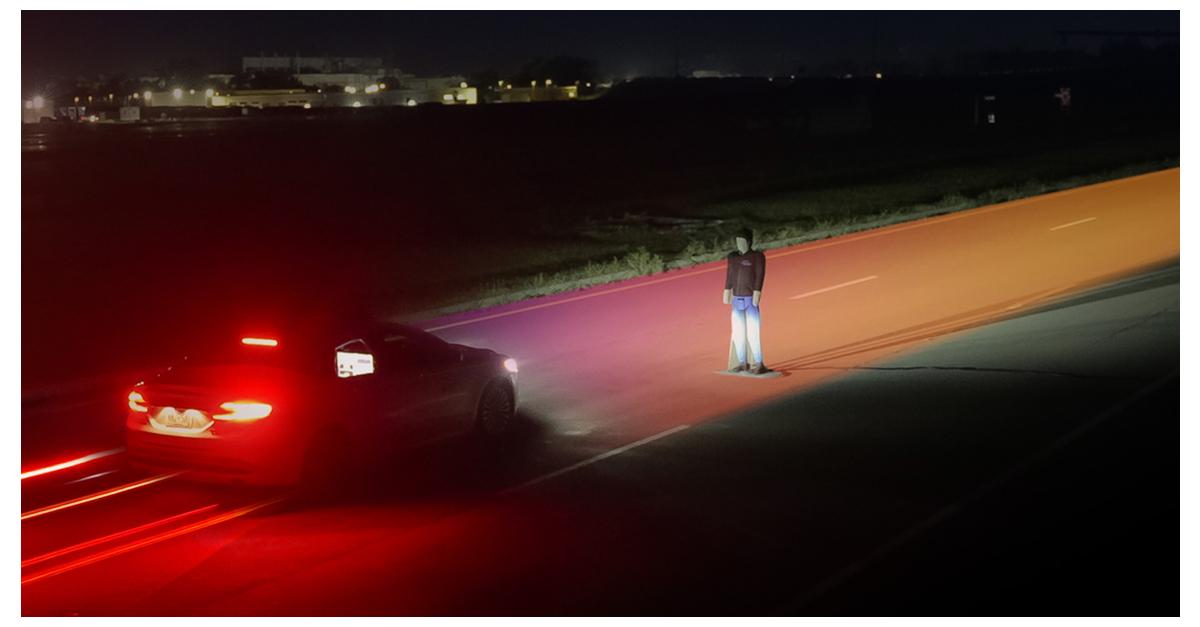R.E.News future Technology-Teledyne FLIR and VSI Labs Lead the Charge in Thermal Vision for Safer Roads
 08/01/25-FR-English-NL-footer
08/01/25-FR-English-NL-footer
Teledyne FLIR et VSI Labs mènent la charge en matière de vision thermique pour des routes plus sûres
 Image- Federal Motor Vehicle Safety Standard (FMVSS) No. 127
Image- Federal Motor Vehicle Safety Standard (FMVSS) No. 127
La course pour répondre aux nouvelles normes de freinage automatique d'urgence pour piétons (PAEB) d'ici 2029 s'intensifie et Teledyne FLIR, aux côtés de VSI Labs, encourage l'innovation pour garantir que la sécurité ne soit pas laissée dans le noir, littéralement.
Des tests récents menés à l'American Center for Mobility (ACM) dans le Michigan ont montré comment la technologie d'imagerie thermique peut aider les constructeurs automobiles à respecter les exigences de la norme fédérale de sécurité des véhicules automobiles (FMVSS) n° 127 pour les systèmes PAEB de nuit.
Cette réglementation impose que d'ici septembre 2029, toutes les voitures particulières et les camions légers pesant jusqu'à 10 000 livres doivent intégrer des systèmes PAEB capables de détecter les piétons dans des conditions d'éclairage variables et à des vitesses accrues. Le nombre de décès de piétons atteignant un pic la nuit (77,7 % des incidents en 2022 se sont produits après le coucher du soleil), il s'agit d'une avancée cruciale.
La National Highway Traffic Safety Administration (NHTSA) a prouvé qu'il était possible de respecter ces critères. Pourtant, les tests montrent que les systèmes de pointe existants, qui s'appuient sur un radar et des caméras visibles, ont souvent du mal à fonctionner dans des scénarios de faible visibilité.
VSI Labs, un leader de l'industrie dans la recherche sur la conduite automatisée, a mis à l'épreuve une Ford Fusion hybride équipée d'un système PAEB à fusion thermique de pointe aux côtés de trois véhicules commerciaux prêts à l'emploi (COTS) 2024. Voici comment les systèmes se sont classés :
Performances de jour :
Les systèmes à fusion thermique et les systèmes COTS traditionnels ont tous deux fonctionné parfaitement lors des tests de jour.
Performances de nuit :
Le système PAEB à fusion thermique a réussi tous les tests, démontrant des capacités de détection supérieures quelles que soient les conditions d'éclairage.
En revanche, les trois systèmes COTS 2024 ont échoué à au moins deux scénarios de nuit, exposant les limites du recours exclusif au radar et aux caméras visibles.
Un élément important des tests comprenait des mannequins piétons thermiquement actifs (PTM), conçus pour reproduire une signature thermique humaine. Ces systèmes ont posé un véritable défi aux systèmes PAEB et ont souligné la valeur de l'imagerie thermique pour détecter avec précision les piétons.
La technologie d'imagerie thermique, comme les caméras automobiles infrarouges à ondes longues (LWIR) de Teledyne FLIR, offre de nombreux avantages qui vont au-delà des suites de capteurs traditionnelles.
Portée de détection améliorée : les caméras thermiques peuvent voir bien au-delà de la portée des phares, ce qui permet de gagner des secondes supplémentaires cruciales pour le freinage.
Visibilité par tous les temps : elles fonctionnent exceptionnellement dans l'obscurité, l'éblouissement, la fumée et la plupart des conditions de brouillard, là où d'autres systèmes échouent.
Sécurité améliorée : en réduisant les faux positifs et en étendant les plages de détection, les caméras thermiques améliorent à la fois le confort de décélération et la sécurité globale.
« Les caméras thermiques offrent une solution économique aux OEM qui souhaitent respecter les normes FMVSS n° 127 », a déclaré Mike Walters, vice-président de la gestion des produits chez Teledyne FLIR OEM. « Grâce à leur capacité à voir dans des conditions difficiles, elles fournissent un avertissement avancé et améliorent les distances de freinage. »
Phil Magney, fondateur de VSI Labs, n’a pas mâché ses mots : « Les trois véhicules COTS ont échoué à au moins deux tests de nuit, ce qui met en évidence la bataille difficile à laquelle sont confrontés les systèmes PAEB actuels pour se conformer à la norme FMVSS n° 127. » Il a ajouté que les scénarios du monde réel présentent des défis encore plus grands, soulignant l’importance d’intégrer des caméras thermiques dans les conceptions de sécurité automobile.
Les observations de Magney correspondent au consensus plus large de l’industrie : si les systèmes actuels sont efficaces pendant la journée, ils ne sont pas à la hauteur lorsque les conditions deviennent imprévisibles. L’imagerie thermique, comme le prouvent ces tests, comble cette lacune, garantissant des routes plus sûres pour tous.
Pourquoi la sécurité nocturne est importante
Le nombre de décès de piétons est en constante augmentation, les incidents nocturnes représentant une part disproportionnée. La combinaison de vitesses plus élevées, d’une visibilité limitée et des limitations des capteurs existants a créé une tempête parfaite pour la sécurité des piétons.
Statistiques clés :
77,7 % des décès de piétons se sont produits la nuit en 2022.
Les systèmes PAEB actuels tombent souvent en panne dans des conditions de faible luminosité ou lorsque la visibilité est compromise.
En intégrant l'imagerie thermique, les constructeurs automobiles peuvent réduire considérablement ces chiffres, garantissant ainsi que les systèmes PAEB avancés fonctionnent de manière fiable dans tous les scénarios d'éclairage.
Tester l'avenir
Les tests rigoureux menés par VSI Labs n'ont pas été une mince affaire. Les essais ont eu lieu les 10 et 11 septembre 2024 dans les installations ultramodernes d'ACM. À l'aide de mannequins piétons adultes chauffés de 4activeSystems, les tests ont reproduit des signatures thermiques réelles pour évaluer les performances du PAEB.
Cet environnement contrôlé a permis une analyse complète, garantissant que les résultats étaient à la fois précis et exploitables. Les constructeurs automobiles disposent désormais d'une feuille de route claire pour répondre aux exigences de la norme FMVSS n° 127, grâce aux recherches et aux technologies révolutionnaires présentées.
Les leaders de l'industrie stimulent l'innovation
Teledyne FLIR, une filiale de Teledyne Technologies, est à l'avant-garde des solutions de détection intelligente depuis 1978. Avec un effectif de 4 000 personnes dans le monde, l'entreprise continue de mener la charge dans la technologie d'imagerie thermique pour les applications de défense, industrielles et désormais automobiles.
VSI Labs, créé en 2014, s'est forgé une réputation comme l'un des meilleurs conseillers du secteur en matière de technologies avancées de sécurité et d'automatisation. Sa collaboration avec Teledyne FLIR met en évidence le potentiel de la combinaison de la recherche de pointe avec une ingénierie de classe mondiale.
Les résultats sont clairs : l'imagerie thermique n'est plus un luxe, c'est une nécessité pour répondre à la prochaine génération de normes de sécurité. À l'approche de l'échéance de la norme FMVSS n° 127 de 2029, les constructeurs automobiles doivent adopter cette technologie pour garantir la conformité et, plus important encore, sauver des vies.
En intégrant des caméras thermiques dans les systèmes PAEB, les fabricants peuvent répondre aux limitations actuelles, réduire les décès de piétons et créer une expérience de conduite plus sûre et plus fiable pour tous.
NJC.© Info Federal Motor Vehicle Safety Standard (FMVSS) No. 127
----------------------------------------------------------------------------------------------------------------------
 08/01/25-English
08/01/25-English
Teledyne FLIR and VSI Labs Lead the Charge in Thermal Vision for Safer Roads
 Image- Federal Motor Vehicle Safety Standard (FMVSS) No. 127
Image- Federal Motor Vehicle Safety Standard (FMVSS) No. 127
The race to meet new pedestrian automatic emergency braking (PAEB) standards by 2029 is heating up, and Teledyne FLIR, alongside VSI Labs, is driving innovation to ensure safety isn’t left in the dark—literally.
Recent tests conducted at the American Center for Mobility (ACM) in Michigan have showcased how thermal imaging technology can help automakers meet the Federal Motor Vehicle Safety Standard (FMVSS) No. 127 requirements for night-time PAEB systems.
This regulation mandates that by September 2029, all passenger cars and light trucks weighing up to 10,000 pounds must integrate PAEB systems capable of detecting pedestrians in varying lighting conditions and at increased speeds. With pedestrian fatalities peaking at night—77.7% of incidents in 2022 occurred after sunset—it’s a critical step forward.
The National Highway Traffic Safety Administration (NHTSA) has proven that meeting these benchmarks is feasible. Yet, tests show existing state-of-the-art systems, which rely on radar and visible cameras, often struggle in low-visibility scenarios.
VSI Labs, an industry leader in automated driving research, put a Ford Fusion Hybrid equipped with a cutting-edge thermal-fused PAEB system through its paces alongside three 2024 commercial off-the-shelf (COTS) vehicles. Here’s how the systems stacked up:
Daytime Performance:
Both the thermal-fused and traditional COTS systems performed flawlessly during daylight tests.
Nighttime Performance:
The thermal-fused PAEB system passed all tests, showcasing superior detection capabilities regardless of lighting conditions.
In contrast, all three 2024 COTS systems failed at least two nighttime scenarios, exposing the limitations of relying solely on radar and visible cameras.
A significant component of the testing included thermally active pedestrian mannequins (PTMs), designed to replicate a human thermal signature. These provided a realistic challenge for the PAEB systems and underscored the value of thermal imaging in accurately detecting pedestrians.
Thermal imaging technology, like Teledyne FLIR’s longwave infrared (LWIR) automotive cameras, delivers a host of advantages that go beyond traditional sensor suites.
Enhanced Detection Range: Thermal cameras can see well beyond the reach of headlights, providing critical extra seconds for braking.
All-Weather Visibility: They perform exceptionally in darkness, glare, smoke, and most fog conditions, where other systems falter.
Improved Safety: By reducing false positives and extending detection ranges, thermal cameras enhance both deceleration comfort and overall safety.
“Thermal cameras offer a cost-effective solution for OEMs aiming to meet FMVSS No. 127 standards,” said Mike Walters, Vice President of Product Management at Teledyne FLIR OEM. “With their ability to see through challenging conditions, they provide advanced warning and improve braking distances.”
VSI Labs’ founder, Phil Magney, didn’t mince words: “All three COTS vehicles failed at least two nighttime tests, highlighting the uphill battle current PAEB systems face in achieving FMVSS No. 127 compliance.” He added that real-world scenarios present even greater challenges, underscoring the importance of incorporating thermal cameras into automotive safety designs.
Magney’s observations align with the broader industry consensus: while current systems are effective during the day, they fall short when conditions become unpredictable. Thermal imaging, as proven in these tests, bridges that gap, ensuring safer roads for everyone.
Why Nighttime Safety Matters
Pedestrian fatalities have been rising steadily, with nighttime incidents accounting for a disproportionate share. The combination of higher speeds, limited visibility, and existing sensor limitations has created a perfect storm for pedestrian safety.
Key statistics:
77.7% of pedestrian fatalities occurred at night in 2022.
Current PAEB systems often fail under low-light conditions or when visibility is compromised.
By integrating thermal imaging, automakers can significantly reduce these numbers, ensuring that advanced PAEB systems perform reliably in all lighting scenarios.
Testing the Future
The rigorous tests conducted by VSI Labs were no small feat. Held on 10-11 September 2024, the trials took place at ACM’s state-of-the-art facilities. Utilising heated adult pedestrian mannequins from 4activeSystems, the tests replicated real-world thermal signatures to evaluate PAEB performance.
This controlled environment allowed for comprehensive analysis, ensuring the results were both accurate and actionable. Automakers now have a clear roadmap for meeting FMVSS No. 127 requirements, thanks to the ground-breaking research and technology showcased.
Industry Leaders Driving Innovation
Teledyne FLIR, a subsidiary of Teledyne Technologies, has been at the forefront of intelligent sensing solutions since 1978. With a workforce of 4,000 worldwide, the company continues to lead the charge in thermal imaging technology for defence, industrial, and now automotive applications.
VSI Labs, established in 2014, has built a reputation as one of the industry’s top advisors for advanced safety and automation technologies. Their collaboration with Teledyne FLIR highlights the potential of combining cutting-edge research with world-class engineering.
The results are clear: thermal imaging is no longer a luxury—it’s a necessity for meeting the next generation of safety standards. With the 2029 FMVSS No. 127 deadline looming, automakers must embrace this technology to ensure compliance and, more importantly, save lives.
By integrating thermal cameras into PAEB systems, manufacturers can address current limitations, reduce pedestrian fatalities, and create a safer, more reliable driving experience for all.
NJC.© Info Federal Motor Vehicle Safety Standard (FMVSS) No. 127
----------------------------------------------------------------------------------------------------------------
 08/01/25-NL
08/01/25-NL
Teledyne FLIR en VSI Labs leiden de strijd in thermische visie voor veiligere wegen
 Image- Federal Motor Vehicle Safety Standard (FMVSS) No. 127
Image- Federal Motor Vehicle Safety Standard (FMVSS) No. 127
De race om te voldoen aan de nieuwe normen voor automatische noodremmen voor voetgangers (PAEB) tegen 2029 is in volle gang en Teledyne FLIR, samen met VSI Labs, stimuleert innovatie om ervoor te zorgen dat veiligheid niet in het donker blijft - letterlijk.
Recente tests die zijn uitgevoerd bij het American Center for Mobility (ACM) in Michigan hebben laten zien hoe thermische beeldtechnologie autofabrikanten kan helpen om te voldoen aan de vereisten van de Federal Motor Vehicle Safety Standard (FMVSS) nr. 127 voor PAEB-systemen in de nacht.
Deze regelgeving vereist dat alle personenauto's en lichte vrachtwagens tot 10.000 pond vanaf september 2029 PAEB-systemen moeten hebben die voetgangers kunnen detecteren bij wisselende lichtomstandigheden en bij hogere snelheden. Aangezien het aantal dodelijke slachtoffers onder voetgangers 's nachts piekt - 77,7% van de incidenten in 2022 vond plaats na zonsondergang - is dit een cruciale stap voorwaarts.
De National Highway Traffic Safety Administration (NHTSA) heeft bewezen dat het halen van deze benchmarks haalbaar is. Toch laten tests zien dat bestaande state-of-the-art systemen, die afhankelijk zijn van radar en zichtbare camera's, vaak moeite hebben in scenario's met weinig zicht.
VSI Labs, een marktleider in onderzoek naar geautomatiseerd rijden, heeft een Ford Fusion Hybrid uitgerust met een geavanceerd thermisch gefuseerd PAEB-systeem getest naast drie commerciële kant-en-klare (COTS) voertuigen uit 2024. Dit is hoe de systemen zich verhouden:
Prestaties overdag:
Zowel het thermisch gefuseerde als het traditionele COTS-systeem presteerden vlekkeloos tijdens tests overdag.
Prestaties 's nachts:
Het thermisch gefuseerde PAEB-systeem slaagde voor alle tests en toonde superieure detectiemogelijkheden, ongeacht de lichtomstandigheden.
Daarentegen faalden alle drie de COTS-systemen van 2024 in ten minste twee nachtelijke scenario's, wat de beperkingen blootlegde van uitsluitend vertrouwen op radar en zichtbare camera's.
Een belangrijk onderdeel van de tests omvatte thermisch actieve voetgangerspoppen (PTM's), ontworpen om een menselijke thermische handtekening na te bootsen. Deze vormden een realistische uitdaging voor de PAEB-systemen en onderstreepten de waarde van thermische beeldvorming bij het nauwkeurig detecteren van voetgangers.
Thermische beeldtechnologie, zoals de langegolf-infrarood (LWIR) autocamera's van Teledyne FLIR, biedt een groot aantal voordelen die verder gaan dan traditionele sensorsuites.
Verbeterd detectiebereik: thermische camera's kunnen ver voorbij het bereik van koplampen kijken, wat cruciale extra seconden biedt om te remmen.
Zichtbaarheid bij alle weersomstandigheden: ze presteren uitzonderlijk in duisternis, schittering, rook en de meeste mistomstandigheden, waar andere systemen falen.
Verbeterde veiligheid: door het verminderen van foutpositieve resultaten en het vergroten van detectiebereiken, verbeteren thermische camera's zowel het comfort bij het vertragen als de algehele veiligheid.
"Thermische camera's bieden een kosteneffectieve oplossing voor OEM's die willen voldoen aan de FMVSS No. 127-normen", aldus Mike Walters, Vice President of Product Management bij Teledyne FLIR OEM. "Met hun vermogen om door uitdagende omstandigheden heen te kijken, bieden ze geavanceerde waarschuwingen en verbeteren ze de remafstanden."
De oprichter van VSI Labs, Phil Magney, draaide er niet omheen: "Alle drie COTS-voertuigen faalden bij ten minste twee nachtelijke tests, wat de zware strijd benadrukt die huidige PAEB-systemen moeten leveren om te voldoen aan FMVSS No. 127." Hij voegde toe dat scenario's in de echte wereld nog grotere uitdagingen met zich meebrengen, wat het belang onderstreept van het opnemen van warmtecamera's in veiligheidsontwerpen voor auto's.
Magney's observaties komen overeen met de bredere consensus in de industrie: hoewel huidige systemen overdag effectief zijn, schieten ze tekort als de omstandigheden onvoorspelbaar worden. Thermische beeldvorming, zoals bewezen in deze tests, overbrugt die kloof en zorgt voor veiligere wegen voor iedereen.
Waarom veiligheid in het donker belangrijk is
Het aantal dodelijke voetgangers is gestaag toegenomen, waarbij incidenten in het donker een onevenredig groot deel uitmaken. De combinatie van hogere snelheden, beperkt zicht en bestaande sensorbeperkingen heeft een perfecte storm gecreëerd voor de veiligheid van voetgangers.
Belangrijkste statistieken:
77,7% van de dodelijke ongevallen met voetgangers vond 's nachts plaats in 2022.
Huidige PAEB-systemen falen vaak bij weinig licht of wanneer het zicht beperkt is.
Door thermische beeldvorming te integreren, kunnen autofabrikanten deze aantallen aanzienlijk verminderen, waardoor geavanceerde PAEB-systemen betrouwbaar presteren in alle lichtscenario's.
De toekomst testen
De strenge tests die door VSI Labs werden uitgevoerd, waren geen geringe prestatie. De proeven vonden plaats van 10 tot en met 11 september 2024 in de ultramoderne faciliteiten van ACM. Met behulp van verwarmde volwassen voetgangerspoppen van 4activeSystems repliceerden de tests echte thermische handtekeningen om de PAEB-prestaties te evalueren.
Deze gecontroleerde omgeving maakte uitgebreide analyses mogelijk, waardoor de resultaten zowel nauwkeurig als bruikbaar waren. Autofabrikanten hebben nu een duidelijke routekaart om te voldoen aan de FMVSS No. 127-vereisten, dankzij het baanbrekende onderzoek en de getoonde technologie.
Brancheleiders stimuleren innovatie
Teledyne FLIR, een dochteronderneming van Teledyne Technologies, loopt sinds 1978 voorop in intelligente sensoroplossingen. Met een personeelsbestand van 4.000 wereldwijd blijft het bedrijf vooroplopen in thermische beeldtechnologie voor defensie, industrie en nu ook automobieltoepassingen.
VSI Labs, opgericht in 2014, heeft een reputatie opgebouwd als een van de beste adviseurs in de branche voor geavanceerde veiligheids- en automatiseringstechnologieën. Hun samenwerking met Teledyne FLIR benadrukt het potentieel van het combineren van baanbrekend onderzoek met engineering van wereldklasse.
De resultaten zijn duidelijk: thermische beeldvorming is niet langer een luxe, maar een noodzaak om te voldoen aan de volgende generatie veiligheidsnormen. Nu de deadline van 2029 FMVSS nr. 127 nadert, moeten autofabrikanten deze technologie omarmen om naleving te garanderen en, nog belangrijker, levens te redden.
Door thermische camera's in PAEB-systemen te integreren, kunnen fabrikanten de huidige beperkingen aanpakken, het aantal dodelijke slachtoffers onder voetgangers verminderen en een veiligere, betrouwbaardere rijervaring voor iedereen creëren.
NJC.© Info Federal Motor Vehicle Safety Standard (FMVSS) No. 127
-------------------------------------------------------------------------------------------------------------------
Date de dernière mise à jour : 07/01/2025
















